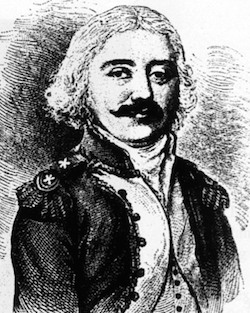General Amédée Emmanuel François Laharpe

Born: September 27, 1754
Place of Birth: Rolle, Switzerland
Died: May 8, 1796
Cause of Death: Killed in action
Place of Death: Codogno, Italy
Arc de Triomphe: LAHARPE on the south pillar
Pronunciation:
Originally a noble from Switzerland, Amédée Emmanuel François Laharpe, sometimes spelled La Harpe, began his military career in 1773 by joining a Swiss regiment in the service of Holland. After returning to Switzerland, in 1781 he became a capitaine of fusiliers at Morges. Ten years later, in July of 1791 Laharpe was proscribed by the authorities in Bern for holding a banquet celebrating liberty at Rolle. He evaded arrest and took refuge in France.
As the French Revolution was now well underway, Laharpe was elected a lieutenant colonel of the 4th Battalion of Volunteers of Seine-et-Oise in October of 1791. In 1792 he served as commander of Bitche and then at the start of 1793 he joined the 35th Infantry Regiment. Laharpe spent 1793 with the Army of the Alps and then he took part in the Siege of Toulon . Towards the end of the siege, Laharpe received a promotion to chef de brigade, and only a few days later he received a second promotion, this time to général de brigade.
In April of 1794 Laharpe took part in the expedition to Oneille and then later the expedition to Saorgio. That September he fought at Cairo and then occupied Vado. The next year Laharpe fought at the combat of Vado and then in August of 1795 he received a promotion to général de division. Commanding the 1st Division of the advance guard under General Masséna, Laharpe led his men into action at Loano in November. In April of 1796, with General Bonaparte now leading the Army of Italy, Laharpe took part in the victories of Montenotte and Millesimo , but his career was soon to be cut short. On the 8th of May, Laharpe and his men captured the city of Codogno. That night as he ate dinner with his staff, they learned of an Austrian force advancing through the town. Laharpe and his staff rushed outside to investigate, and after the Austrian force was found and captured, his staff realized their general was not with them. A hurried search of the area found his body, with one shot having killed him. Due to the confusion and limited visibility during the night, it was impossible to ascertain whether he was killed by enemy or friendly fire.1
Notes
- Martin Boycott-Brown, The Road to Rivoli: Napoleon's First Campaign, (London: Cassell, 2001), 303-304.
Bibliography
- Divry, Arnauld. Les Noms Gravés sur l'Arc de Triomphe. Paris: L'Harmattan, 2017.
- Six, Georges. Dictionnaire Biographique des Généraux & Amiraux Français de la Révolution et de l'Empire (1792-1814). 2 vols. Paris: Gaston Saffroy, 2003.
Updated May 2023
© Nathan D. Jensen